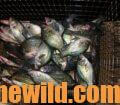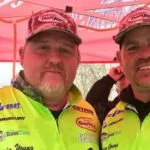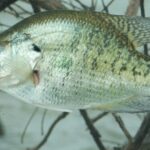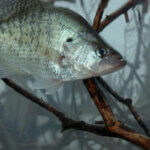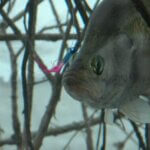Editor’s Note: Nighttime crappie fishing is one of the most addictive forms of fishing I know. Crappie fishing at night in the summer is cool, relaxing, rewarding, and an ideal way to spend quality time with friends and family away from the rest of the world. Also, crappie fishing at night doesn’t interfere with any of my daytime activities. I can fish in the afternoons after work, fish all night Friday and Saturday, and still have Sunday after church to recover.
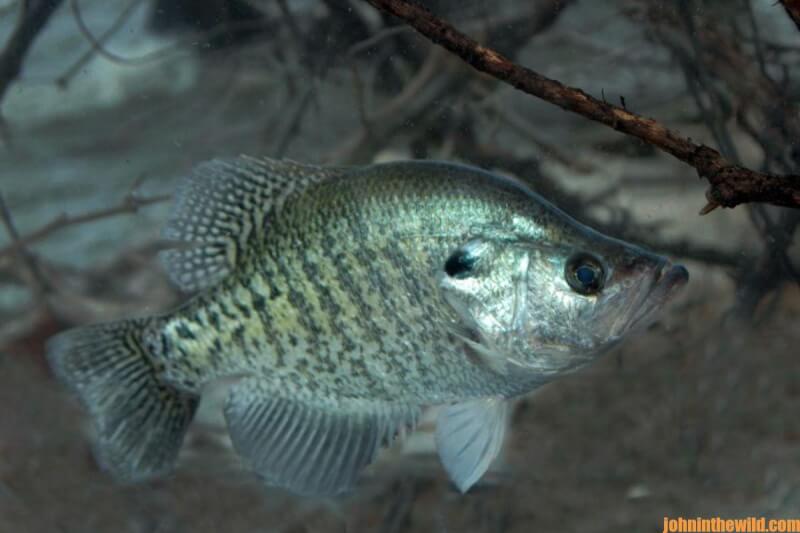
Catching Crappie in Hot Weather
To catch hot-weather crappie, a fisherman must know what causes crappie to leave their deep-water haunts and move into shallow water when the temperature climbs high enough to fry eggs on the sidewalk. Larry Battison of Georgetown, Georgia, is a nighttime crappie fisherman, who fishes Alabama’s Lake Eufaula on the Alabama/Georgia border. He rarely, if ever, lifts the lid on his ice chest or his livewell when someone asks, “Have you caught any fish?” He’ll say, “The weather’s so hot out on the lake, I can’t believe a fish will bite anywhere.”
But Battison generally has a cooler full of big slab crappie he’s caught at a time when and at places where most other anglers don’t fish during the summer months.

“Lake Eufaula near my home has about three or four, underwater bridges that are still intact,” Battison explains. “In your area of the U.S., you can find these bridges by looking at old road and river maps that show train trestles and bridges crossing small creeks and rivers before the lake has been impounded.
Crappie often suspend under these bridges and above these old creek channels. But you’ll have difficulty catching them unless you use two grappling hooks to hold your boat in place.”
Battison Perfected His Crappie Fishing Technique with Underwater Bridges
Battison tried to catch the underwater-bridge crappie for several years before he developed his grappling-hook technique. One bridge he fished was out on the main part of the lake where waves caused his anchors to come up and moved his boat away from the edge of the bridge.
Battison learned that if his minnows or jigs didn’t fall right beside the bridge where the crappie could see them, the fish wouldn’t move out from under the bridge to take them. He had to find a way to keep his line and minnows right along the edge of the underwater bridge.
So, Battison came up with a grappling hook tactic that would enable his boat to stay right on the lip of the break and let him fish with his line lying right beside and touching the old bridge.
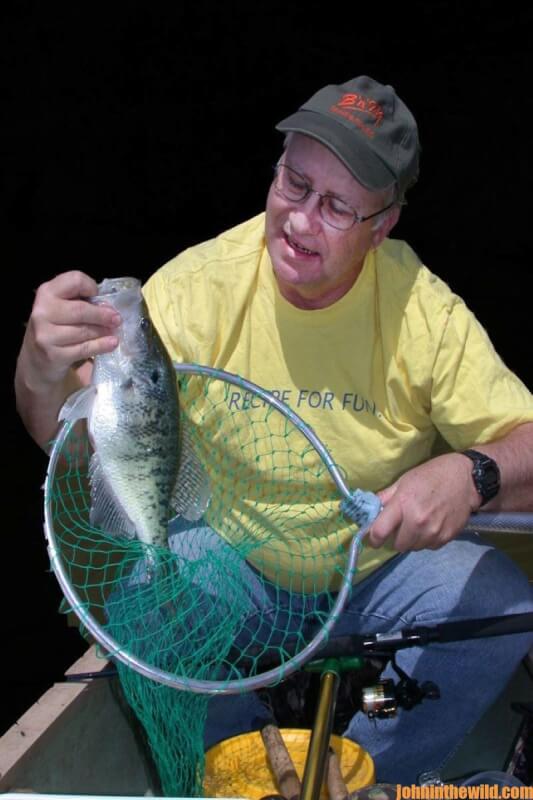
“I made an anchor resembling a grappling hook from pieces of aluminum with a 4-foot piece of aluminum sticking straight up and four spikes coming off the main shaft,” Battison says. “I’d lower the anchor/grappling hook down and catch the underside of the bridge with at least two of the four prongs. Then I’d tighten up on the rope and run the end of the rope through a bungee cord I’d hooked onto the cleat on the side of my boat.
“Once I got the first grappling hook secured to the side of the bridge, I’d hook up a second grappling hook to the stern. The grappling hook would hold the boat next to the bridge. The bungee cord let the boat rock back and forth without creating slack on the rope that held the grappling hook to the base of the bridge.”
Then Battison baited his rods with live minnows and slowly let the lines down the side of the bridge. He kept most of his rods inside the boat with just the tips of the rods over the sides of the boat.
He usually could feel the side of the bridge with his line as he lowered a minnow down to swim right on the bottom edge of the bridge where the crappie were holding. The bridge provided shade, structure, and a place for the baitfish to concentrate.

Although a number of people fish this bridge, Battison has learned to fish the edges of the two pilings that sit on the underwater riverbank and support the span of the bridge. Those bridge pilings offer vertical structure over the edge of the deep water, which means the crappie can hold vertically wherever they want under the shade of the bridge.
Often at night during the summer months, Battison will use his grappling hooks to hold him on the break of the old underwater bridge. He’s learned that crappie move out from under the bridge and hold on top of the bridge when the sun goes in, and the moon comes out.
The later he fishes into the night, the closer to the surface he’ll catch crappie.
The fish will move up because he uses either a Coleman lantern or floating lights to attract the bait fish on which the crappie will feed. With Battison’s grappling-hook method, he holds his boat on the lip of the break. He can fish minnows either under the submerged bridge by day or on top of the bridge by night.
Tomorrow: What You Can Use to Attract Nighttime Crappie
When you use the links below to go to Amazon, notice on the left of the Audible option where Amazon says you can hear a sample that gives you 10% of these books for free! On the right side of the page for each book and below the offer for a free Audible trial, you can choose to Buy the Audible book.
Be sure to also check out John’s Free Books as our gift to you!
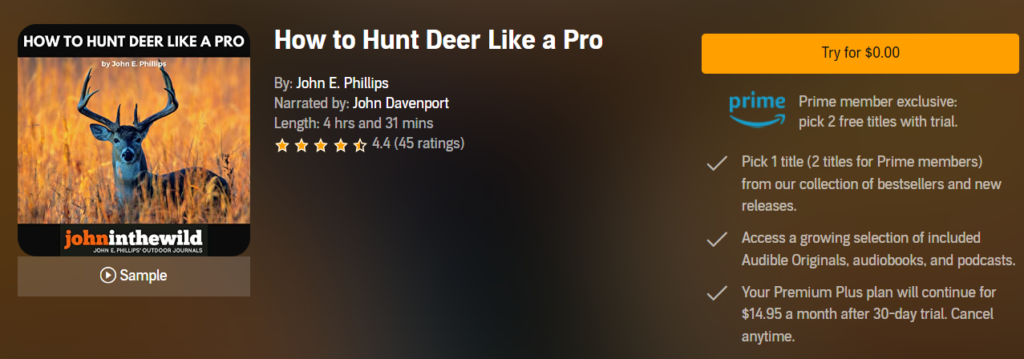
Prime Members: You’re eligible to claim 2 free titles with your 30-day Audible Premium Plus trial! Browse more than 100 of John E. Phillips’ expert guidebooks on hunting and fishing here.
Books By Topic
Category Shortcuts: View on Amazon
| Deer Hunting | Turkey Hunting | Elk Hunting | Bass Fishing |
| Mule Deer Hunting | Bowhunting | Bowfishing | Crappie Fishing |
| All Cookbooks | Hunting Cookbooks | Fishing Cookbooks | All Audible Books |
Expert Guidebooks on Crappie Fishing: Best Sellers
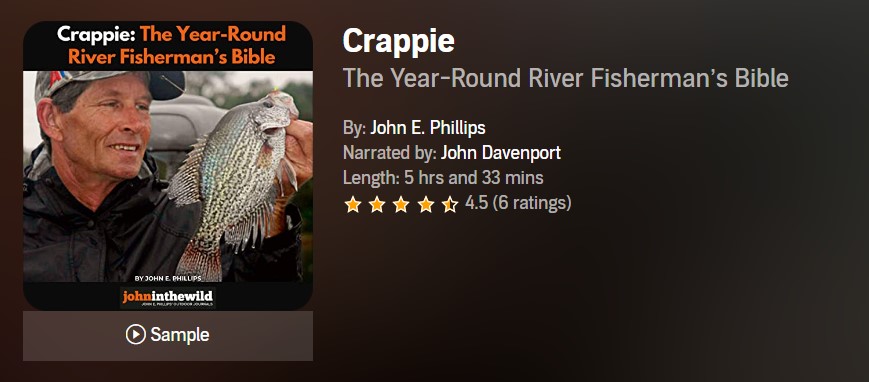
Fishing rivers for crappie and being able to find and catch speckled sides consistently has long been one of the mysteries in the crappie-fishing world.
“One of the reasons that river systems are so difficult to fish is because the water’s either rising or falling in them,” says Ott DeFoe, the 2019 Bassmaster Classic champion.
Rivers also are very susceptible to floods and droughts and constantly have current moving through them. Often fast current or slow current in rivers is created by rain or droughts upstream. When rivers flood, they can wash away fish habitat like logs, sunken trees, manmade brush piles and stake beds. But that’s the time when a river also creates new crappie hot spots that haven’t been available to the crappie or the fishermen before the flood.
Because river systems are so unpredictable, I’ve felt the best way to get the most useful information on how to fish rivers for crappie is to talk to numbers of anglers all over the nation to learn their best tactics.
In this book, I’ve gleaned crappie-fishing wisdom from three dozen crappie anglers and guides from a dozen states, who consistently catch crappie at all times of the year. The tournament crappie fishermen in this book fish most of the country at different times of the year on various river systems and lakes. And, these anglers use techniques you never may have considered, including:
- Setting up a casting ring with your electronics to keep you from getting too close to the crappie that are holding on underwater structure, while you’re fishing all the way around the structure;
- Buying an automotive laser temperature gauge to measure water temperature
- Evaluating the most-productive places to sink brush and other structure, according to prevailing wind direction, the crappie’s summer, fall, winter, and spring migration patterns, and other factors.
VERSIONS: AUDIBLE, KINDLE & PRINT
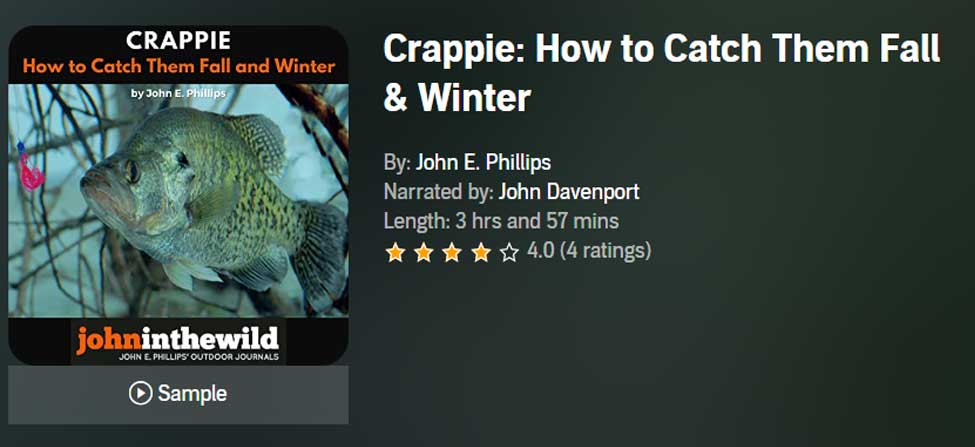
Crappie: How to Catch Them Fall & Winter
Yes, you can catch and eat crappie during the fall and winter months. Often, at many places, you’ll catch more and bigger crappies in the fall and winter than you do in the spring and summer. To learn where to find and how to catch cooler weather speckled sides, we’ve interviewed a wide variety of some of the nation’s best tournament crappie fishermen and guides.
Many of the individuals you’ll hear about in this audiobook are tournament crappie pros who travel the country to fish in crappie tournaments from New York to Florida and from Virginia to California. They use the latest crappie-finding equipment, the best poles, rods, reels, line, and the most-productive baits. Each of the people mentioned in this book has the ability to be dropped out of an airplane anywhere in the United States and catch crappie on any lake close to where they land that contains crappie.
From over 50 years of crappie-fishing experience, I’ve learned that you get the best advice by interviewing a large number of people who have different tactics and fish under various water, weather, and fishing-pressure conditions.
In this book, you will learn:
- How to spider-rig (slow-troll), which is one of the fastest-growing techniques for catching the most and biggest crappies in the shortest time
- How to catch crappie on crank baits and when and where using a crank bait is the most appropriate
- How to find areas of any lake that will hold large schools of crappies during the winter months – places you can return to time and again and expect them to be there
- Why competing in crappie tournaments is one of the quickest ways to learn how to catch more and bigger crappie faster
- Why and how to look for and catch the biggest crappie in a lake
VERSIONS: AUDIBLE, KINDLE & PRINT

Catch Crappie All Year: Fishing a Single Pole, Using No Boat, and Farming Crappie
I’ve interviewed some of the best crappie fishermen in the nation for my new audiobook, Catch Crappie All Year: Fishing a Single Pole, Using No Boat and Farming Crappie to learn how, where, and when to catch the most crappie with or without a boat while single-pole fishing. I’ve also included information on how to grow a crop of crappie to catch every day of the year. Although I’ve fished in fully rigged crappie boats costing $45,000 – $90,000-plus that can have up to 16 rods at one time to slow troll, I still enjoy….
- Watching a quill cork sink in a brush top
- Fishing with an ultralight spinning rod
- Reeling jigs or minnows along a grass line and feeling that thud when a crappie takes the bait
- Fishing with family and friends, even if we all can’t fit in one boat
- Participating in less-expensive and hassle-free yet highly-productive crappie fishing like single poling
I’ve tried to capture in this new audiobook the old way of crappie fishing with new twists and detailed tactics to aid you in catching crappie all year.
VERSIONS: AUDIBLE, KINDLE & PRINT
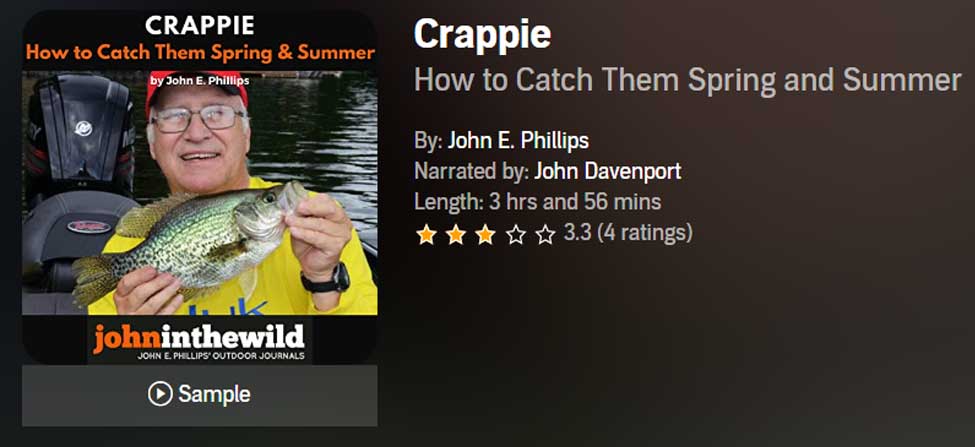
Crappie: How to Catch Them Spring and Summer
You can catch crappie all year long if you know where to find them and what techniques to use to catch them. However, crappie fishing is so technical these days, and we’ve learned so much about how to crappie fish because of the professional crappie-fishing circuits, that one book can’t hold all the information.
This book is the first of a three-part series on how, where, and when to catch crappie, with the best crappie fishermen in the nation. Many of these men have proven they are the best, because they’ve won crappie-fishing tournaments or been successful fishing guides for many years.
This audio version of Crappie: How to Catch Them Spring and Summer includes crappie pros like Ronnie Capps, who has won seven national championships and over $1 million with his partner Steve Coleman.
We also have Malcolm Lane, Stokes McClellan from North Carolina, Billy Blakeley from Reelfoot Lake, John Woods, Kent Driscoll, fishing biologist and professional basser Ken Cook, and many others. We asked the questions that crappie fishermen want answered about how to find and catch crappie during the spring and summer months, and these fishing tips are the result.
In the world of crappie fishing, no one man knows it all, and that’s why I’ve interviewed so many fishermen, asked so many questions, and tried to get so many answers for you about how to fish.
VERSIONS: AUDIBLE, KINDLE & PRINT


